The 10 Best Trees for Urban Wildlife Gardens in 2024
Introduction
Did you know that a single oak tree can support over five hundred species of caterpillars ? That’s incredible! As urban sprawl continues to encroach on natural habitats, our gardens have become crucial sanctuaries for wildlife. We’re here to help you transform your urban oasis into a bustling ecosystem with the right tree choices. Let’s explore the best trees for urban wildlife that’ll have your garden teeming with life in no time!
Why Urban Wildlife Gardens Matter
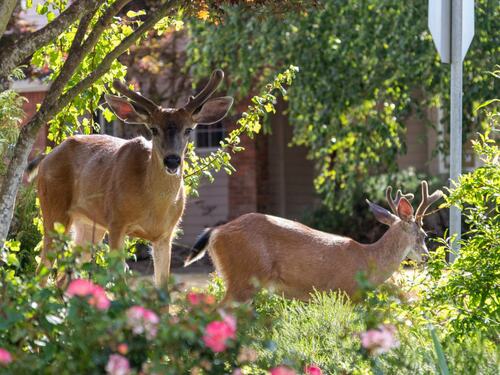
Deer Grazing in a Suburban Yard
Urbanization has dramatically altered natural landscapes, often at the expense of wildlife habitats. As concrete jungles expand, green spaces shrink , leaving many species struggling to find food, shelter, and breeding grounds. This is where urban wildlife gardens come into play.
Creating wildlife-friendly spaces in cities isn’t just a hobby—it’s a vital contribution to conservation efforts. These green havens provide essential resources for various creatures, from insects and birds to small mammals. They act as stepping stones between larger natural areas, facilitating the movement and survival of species in urban environments.
Trees play a pivotal role in these urban ecosystems. They offer:
- Food sources through fruits, nuts, and nectar
- Nesting sites for birds and small mammals
- Shelter from predators and harsh weather
- Habitats for countless insect species
By planting the right trees , you’re not just beautifying your space—you’re creating a life-supporting system for urban wildlife.
Factors to Consider When Choosing Trees for Wildlife
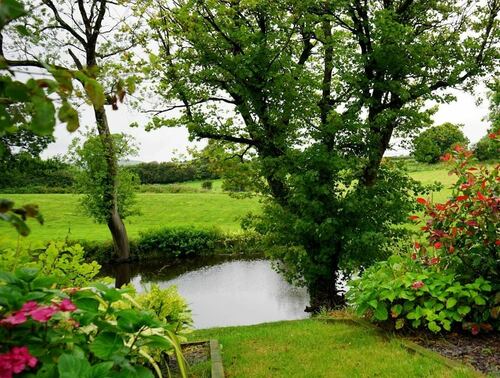
A Serene Backyard Wildlife Haven – Photo by Mike Bird
Before we dive into our “top ten” list, let’s consider some crucial factors in selecting the best trees for urban wildlife:
Native vs. Nonnative Species
While the debate continues, native species often have the edge. They’ve co-evolved with local wildlife, providing optimal nutrition and habitat. However, some nonnative species can also support wildlife without becoming invasive.
Size and Growth Rate
Urban spaces often have limitations. Consider mature tree size and growth rate to ensure your choice fits your space long-term.
Soil Type and Climate Adaptability
Choose trees that thrive in your local soil and climate conditions. This ensures healthy growth and reduces maintenance needs.
Maintenance Requirements
Some trees need more care than others. Consider your time and resources when selecting trees for your wildlife garden.
Top 10 Best Trees for Urban Wildlife Gardens
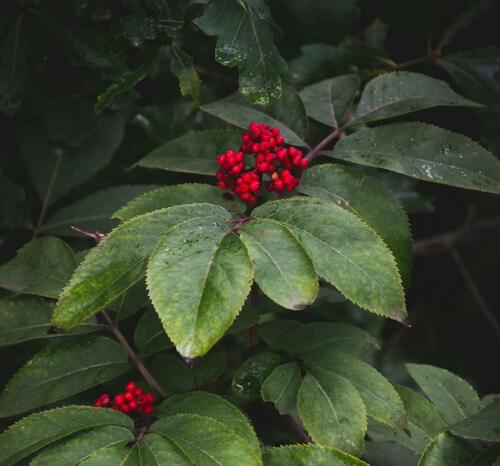
Elderberry Tree Branches with Fruit – Image by Vika Glitter
Now, let’s explore the cream of the crop when it comes to supporting urban wildlife:
1. Oak
Oaks are the undisputed champions of wildlife support. They provide:
- Acorns, a vital food source for many species
- Excellent nesting sites for birds
- Habitat for hundreds of insect species
Popular urban-friendly varieties include the white oak and pin oak.
2. Maple
Maples offer year-round benefits for wildlife:
- Spring flowers attract pollinators
- Winged seeds (samaras) feed birds and small mammals
- Dense foliage provides nesting sites
Consider the red maple or sugar maple for urban settings.
3. Birch

A Birch Tree with Iconic White Bark – Photo by Maksim Zaviktorin
Birches are beautiful biodiversity boosters:
- Catkins provide early spring food for birds
- Seeds feed many bird species
- Bark attracts insect-eating birds
The river birch is an excellent choice for urban gardens.
4. Cherry
Cherry trees are wildlife magnets:
- Spring blossoms attract pollinators
- Fruits feed birds and mammals
- Leaves support various caterpillar species
Try the black cherry for a native option.
5. Hawthorn

Hawthorn Flowers on a Leafy Branch – Photo by DominikRH on Pixabay
Hawthorns are compact powerhouses for wildlife:
- Dense, thorny branches provide safe nesting sites
- Berries offer winter food for birds
- Flowers attract pollinators
The Washington hawthorn is a great urban choice.
6. Rowan
Also known as mountain ash , rowans offer:
- Clusters of berries that persist into winter, feeding birds
- Spring flowers for pollinators
- Attractive foliage that supports insect life
7. Willow
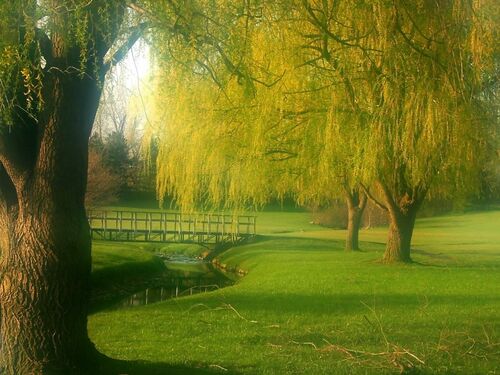
Willow Trees in Light Fog
Willows are excellent for wildlife, especially near water:
- Early catkins provide crucial early-season pollen
- Soft wood attracts nesting birds and insects
- Leaves feed various caterpillar species
The white willow is a good urban option.
8. Crabapple
Crabapples pack a punch for wildlife:
- Spring blossoms attract pollinators
- Small fruits persist into winter, feeding birds
- Dense structure provides nesting sites
Try the prairie crabapple for a native variety.
9. Holly
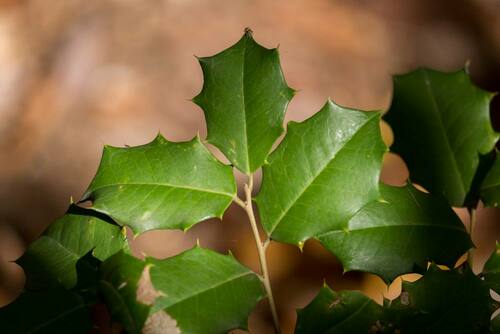
The Prickly Leaves of a Holly Tree
Hollies offer year-round benefits:
- Evergreen foliage provides winter shelter
- Berries feed birds in late winter
- Dense growth offers nesting sites
The American holly is an excellent native choice.
10. Elderberry
Elderberries are wildlife favorites:
- Fragrant flowers attract pollinators
- Berries feed birds and small mammals
- Fast growth provides quick habitat establishment
The American elderberry is perfect for urban wildlife gardens.
Oak: The Wildlife Powerhouse

An Enormous White Oak Tree – Photo by cfreeland8 on Pixabay
Let’s take a closer look at why oaks top our list of the best trees for urban wildlife.
Various Oak Species for Urban Gardens
While many oaks grow quite large, several species are suitable for urban settings:
- Pin Oak: Tolerates urban conditions well
- Willow Oak: More compact with fine-textured foliage
- Bur Oak: Adaptable and drought resistant
Wildlife Benefits
Oaks are unparalleled in their support for wildlife:
- Acorns: A crucial food source for over one hundred vertebrate species
- Nesting Sites: Large branches and cavities provide homes for birds and mammals
- Insect Habitats: Support over five hundred species of caterpillars alone
Growth Characteristics and Care Tips
- Growth Rate: Moderate to fast, depending on species
- Sunlight Needs: Full sun to partial shade
- Soil Preferences: Adaptable, but prefer well-drained soils
- Pruning: Minimal pruning needed; focus on removing dead or diseased branches
Maple: A Year-Round Wildlife Magnet

A Maple Branch Forming Fruit and Seeds – Photo by Lana
Maples offer diverse benefits throughout the seasons.
Different Maple Varieties for Urban Settings
- Red Maple : Adaptable and fast growing
- Sugar Maple: Known for brilliant fall colors
- Japanese Maple: Smaller option for compact spaces
Seasonal Attractions for Wildlife
- Spring: Early flowers provide nectar for pollinators
- Summer: Dense foliage offers nesting sites and shelter
- Fall: Vibrant foliage attracts insects
- Winter: Winged seeds (samaras) feed birds and small mammals
Ideal Planting and Maintenance Advice
- Plant in full sun to partial shade
- Provide well-drained, slightly acidic soil
- Water regularly during the first growing season
- Prune in late winter or early spring to shape and to remove dead branches
Birch: The Beautiful Biodiversity Booster
Birches add both aesthetic appeal and wildlife value to urban gardens.
Popular Birch Species for Wildlife Gardens
- River Birch: Heat tolerant and resistant to bronze birch borer
- Paper Birch: Known for its striking white bark
- Yellow Birch: Aromatic leaves and golden bark
Benefits for Birds, Insects, and Small Mammals
- Birds: Seeds, buds, and catkins provide food; bark attracts insect-eating species
- Insects: Leaves support various caterpillar species
- Small Mammals: Seeds and buds offer food sources
Tips for Successful Birch Tree Cultivation
- Plant in cool, moist areas with partial shade
- Maintain consistent soil moisture
- Mulch to keep roots cool and retain moisture
- Monitor for pests, especially in urban environments
Fruit Trees: Cherry and Crabapple Delights
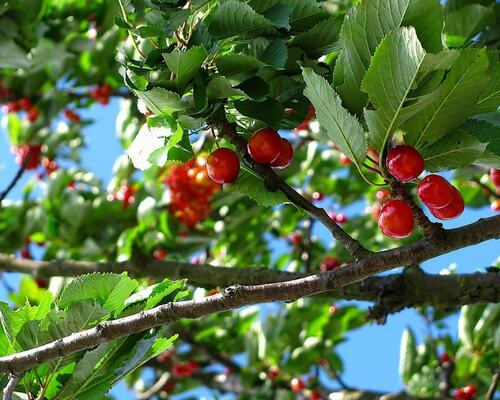
A Fruit-Laden Cherry Tree – Photo by Jingoba on Pixabay
Fruit trees offer a bounty of resources for urban wildlife.
Comparison of Cherry and Crabapple for Wildlife
- Cherry: Larger fruits, attractive to a wide range of species
- Crabapple: Smaller fruits persist longer, providing winter food
How Fruit Trees Support Various Species
- Pollinators: Spring blossoms provide nectar and pollen
- Birds: Fruits offer food throughout summer and fall
- Mammals: Fallen fruits feed ground-dwelling species
Pruning and Care for Optimal Fruit Production
- Prune in late winter to encourage fruit production
- Thin fruits to improve size and quality
- Monitor for pests and diseases common in urban environments
Designing Your Urban Wildlife Garden
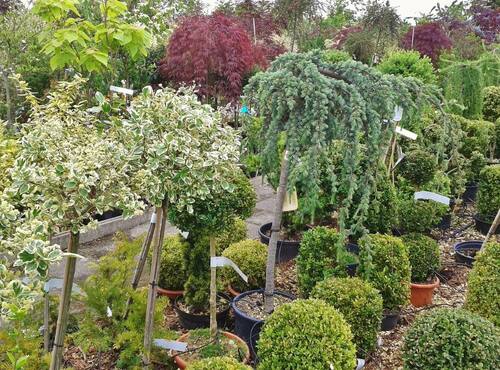
A Variety of Nursery Trees for Sale – Image by cocoparisienne on Pixabay
Creating a diverse, layered habitat is key to attracting a variety of wildlife.
Creating Diverse Habitats with Mixed Tree Plantings
- Combine trees of different heights and structures
- Include both deciduous and evergreen species
- Plant in groups to create denser habitats
Incorporating Understory Plants and Shrubs
- Add native shrubs like elderberry or serviceberry
- Include flowering perennials to attract pollinators
- Use ground covers to provide shelter for small creatures
Water Features and Their Role in Attracting Wildlife
- Install a small pond or birdbath
- Create a rain garden to manage runoff and attract wildlife
- Ensure a year-round water source, even in winter
Maintenance Tips for a Thriving Wildlife Garden
Proper care ensures your urban wildlife garden remains healthy and attractive.
Pruning Practices that Benefit Both Trees and Wildlife
- Avoid pruning during nesting season (usually spring to early summer)
- Leave some dead branches for cavity-nesting birds
- Prune to maintain tree health and structure
Natural Pest Control Methods
- Encourage beneficial insects by planting diverse native species
- Use physical barriers like tree guards to prevent damage
- Avoid chemical pesticides that can harm wildlife
Seasonal Care Routines
- Spring: Plant new trees; remove winter protection
- Summer: Water during dry spells; monitor for pests
- Fall: Plant trees; collect leaves for compost or mulch
- Winter: Prune deciduous trees; provide water sources
Conclusion
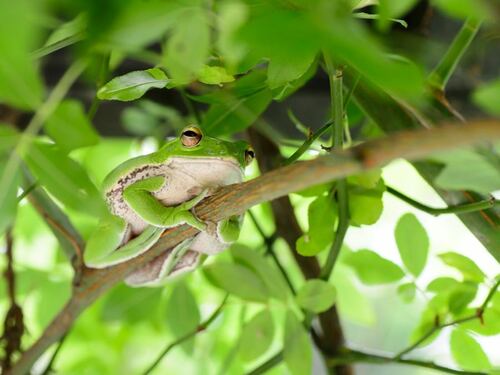
A Frog Clings to a Tree Branch – Image by Pixabay
Planting the best trees for urban wildlife isn’t just about beautifying your space—it’s about creating a thriving ecosystem right in your backyard! By choosing from our “top ten” list and following our expert tips, you’ll be well on your way to supporting a diverse array of creatures. Remember, every tree you plant is a step toward a greener, more vibrant urban environment. So, why wait? Get planting and watch your garden come alive within the wonders of nature!
For professional advice on selecting and caring for the best trees for your urban wildlife garden, contact Arborist Now , your local tree care experts.


